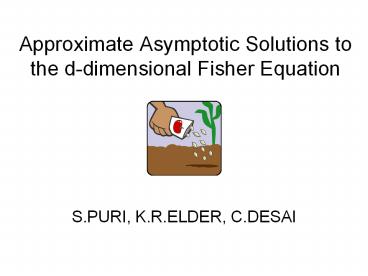Approximate Asymptotic Solutions to the d-dimensional Fisher Equation - PowerPoint PPT Presentation
1 / 14
Title:
Approximate Asymptotic Solutions to the d-dimensional Fisher Equation
Description:
We will confine ourselves to the physically interesting. case. ... An interesting condition is one in which we have a populated site in a ... – PowerPoint PPT presentation
Number of Views:66
Avg rating:3.0/5.0
Title: Approximate Asymptotic Solutions to the d-dimensional Fisher Equation
1
Approximate Asymptotic Solutions to the
d-dimensional Fisher Equation
- S.PURI, K.R.ELDER, C.DESAI
2
Nonlinear reaction-diffusion equation (1)
- We will confine ourselves to the physically
interesting - case.
- Consider the Fourier transform of (1).
3
We can write the expansion for as
(3)
- We will make 4 approximations.
- ?Approximation 1
- We can rewrite (3) as
- (4)
-
- where
4
- where and
5
- Calculate using the time integral and Laplace
transform, we - get
- (5)
- where and
6
?Approximation 2 In (5), the dominant term
is the one with the largest
- The largest is for
- Under this approximation, we have
7
By simplifying and calculating, becomes
- (6)
8
?Approximation 3 In (6), we need the point where
the exponential term is maximum.
- This maxima arises for
- Thus, we can further approximate as
9
Then, it reduces to
- (7)
10
?Approximation 4 In (7), we will consider only
the modes. (It is necessary so as to
put the solution into a summable form.)
- Under this approximation, we have
- and from (4)
- (8)
11
In (8), taking the inverse Fourier transformation
on both sides, we have
- (9)
12
An interesting condition is one in which we have
a populated site in a background of zero
population
- seed amplitude
- the location of the
initial seed
13
The solution corresponding to (9) for this
initial condition is
- (10)
14
Lets assume the midpoint of the interface is
located at time t and at the distance r(t). (also
let 0 and 1)
- Substituting into
(10), we obtain - The analytic solution corresponds to domain
growth with an - asymptotic velocity in all dimensions.































